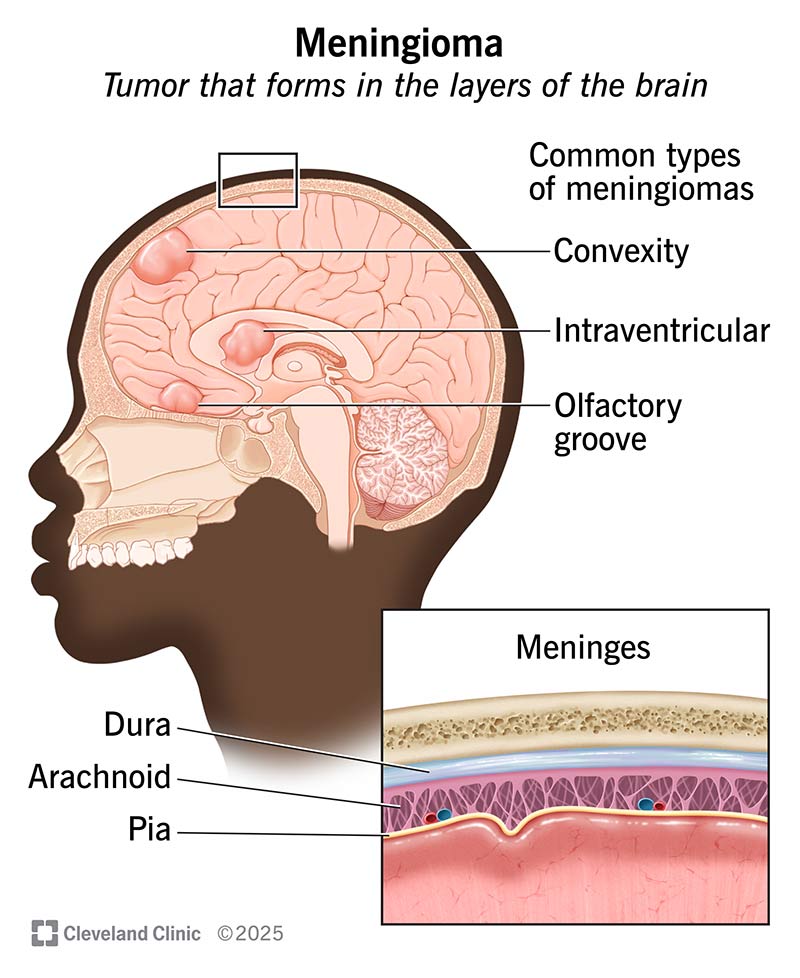In this article, you will gain a deeper understanding of meningioma tumors, a type of brain tumor that affects the meninges, the protective membranes covering the brain and spinal cord. Discover the key characteristics of meningioma tumors, their potential causes, and the different treatment options available. By exploring the intricacies of this condition, you will be empowered to make informed decisions about your health and engage in meaningful discussions with healthcare professionals. Let’s dive in and unravel the complexities of meningioma tumors together.
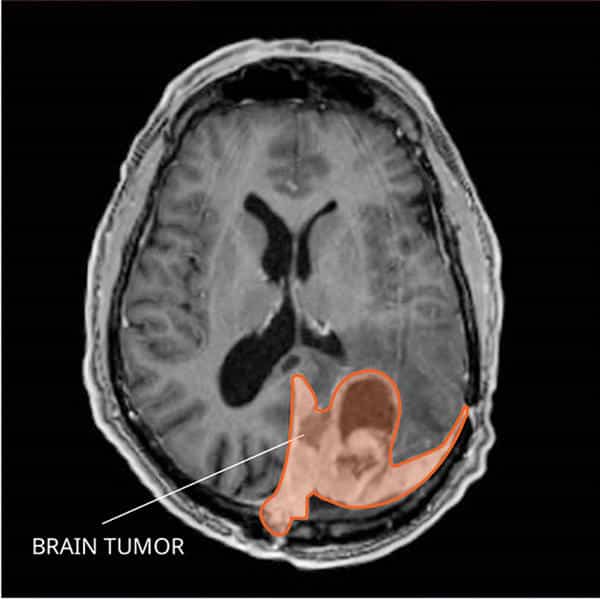
What is Meningioma?
Meningioma is a type of tumor that develops in the meninges, which are the protective membranes that cover the brain and spinal cord. These tumors are typically slow-growing and are often benign, meaning they are not cancerous. However, in some cases, meningiomas can be malignant and spread to other parts of the body. Meningiomas can occur at any age, but they are most commonly diagnosed in people between the ages of 40 and 70.
Definition
A meningioma is a tumor that originates in the meninges, the membranes that surround the brain and spinal cord. These tumors are classified as either benign or malignant, depending on their characteristics and behavior. Benign meningiomas are non-cancerous and tend to grow slowly, while malignant meningiomas are cancerous and can grow more rapidly.
Prevalence
Meningiomas are the most common type of primary brain tumor, accounting for approximately 37% of all brain tumors. They are more commonly diagnosed in women than in men, with a female-to-male ratio of about 3:2. The exact cause of this gender difference is unknown, but hormonal factors may play a role. Meningiomas can occur at any age, but they are most frequently diagnosed in individuals between the ages of 40 and 70.
Types of Meningioma
There are several different types of meningioma, categorized based on the appearance of the tumor cells and the location of the tumor within the brain or spinal cord. Some common types include:
-
Convexity Meningioma: This type of meningioma occurs on the outer surface of the brain and is often attached to the dura mater, the thick membrane that covers the brain.
-
Skull Base Meningioma: These tumors originate at the base of the skull and can be challenging to remove due to their proximity to critical structures such as blood vessels and nerves.
-
Spinal Meningioma: This type of meningioma forms within the spinal cord or the membranes that surround it. Spinal meningiomas can cause symptoms such as back pain, weakness, and difficulty with coordination.
-
Cerebellopontine Angle Meningioma: Located near the brainstem and cranial nerves, these tumors can affect hearing, balance, and facial movement.
Causes and Risk Factors
The exact cause of meningioma is unknown, but several factors have been identified as potential contributors to the development of these tumors. It is believed that a combination of genetic and environmental factors may play a role.
Genetics
There is evidence to suggest that certain genetic mutations and chromosomal abnormalities may increase the risk of developing meningioma. In some cases, these genetic changes can be inherited, while in others, they may occur spontaneously.
Hormonal Factors
Hormonal factors, particularly the female sex hormones estrogen and progesterone, may influence the development and growth of meningiomas. This is supported by the observation that meningiomas are more common in women, especially during pregnancy and menopause when hormone levels fluctuate.
Exposure to Radiation
Exposure to ionizing radiation, such as radiation therapy for other conditions, has been associated with an increased risk of developing meningioma. The risk is highest when radiation is received at a young age and in high doses.
Previous Trauma
Some studies have suggested a potential link between head trauma and the development of meningiomas. However, the relationship between trauma and meningioma is still not fully understood, and more research is needed to establish a clear connection.
Symptoms
The symptoms of meningioma can vary depending on the location, size, and growth rate of the tumor. Some common symptoms include:
Headaches
Headaches are one of the most common symptoms of meningioma. They can vary in intensity and may be persistent or intermittent. The headaches are often described as dull or throbbing and may worsen over time.
Seizures
Seizures can occur when a meningioma irritates or compresses the brain tissue. These seizures may present as uncontrollable shaking, loss of consciousness, or unusual sensations and movements.
Changes in Vision
Meningiomas located near the optic nerves or visual pathways can cause changes in vision. This may include blurred vision, double vision, loss of peripheral vision, or even blindness in severe cases.
Cognitive and Behavioral Changes
Depending on the size and location of the tumor, meningiomas can affect cognitive function and behavior. Some individuals may experience memory problems, difficulty concentrating, personality changes, or mood swings.
Diagnosis
Diagnosing meningioma involves a variety of tests and examinations to assess the location, size, and characteristics of the tumor. The diagnostic process typically involves the following steps:
Medical History and Physical Examination
Your doctor will begin by taking a detailed medical history and conducting a physical examination. They will ask about your symptoms, medical conditions, and any potential risk factors. During the physical examination, the doctor will assess your neurological function and look for any signs of abnormality.
Neurological Examination
A neurological examination is performed to evaluate your brain and spinal cord function. This may include testing your reflexes, muscle strength, coordination, and sensory perception. Any abnormalities in these areas may suggest the presence of a meningioma.
Imaging Tests
Imaging tests such as magnetic resonance imaging (MRI) and computed tomography (CT) scans are essential in diagnosing meningioma. These tests provide detailed images of the brain and spinal cord, allowing the healthcare team to locate and evaluate the tumor. In some cases, additional imaging tests such as angiography or positron emission tomography (PET) scans may be performed to gather more information about the tumor’s characteristics and blood supply.
Biopsy
A biopsy may be recommended to confirm the diagnosis of meningioma. During a biopsy, a small sample of the tumor tissue is removed and examined under a microscope. This helps determine whether the tumor is benign or malignant and guides treatment decisions.
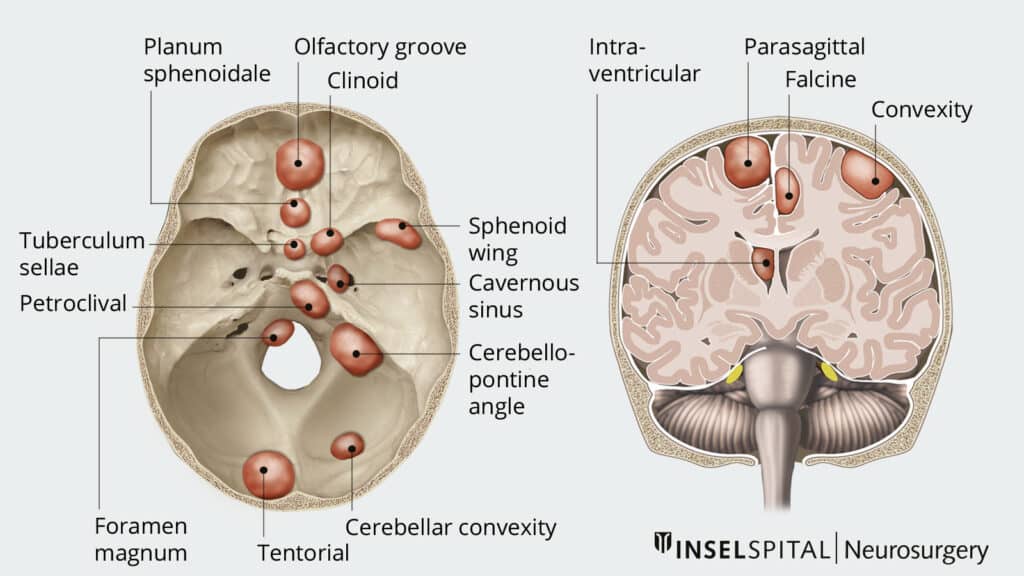
Treatment Options
The treatment options for meningioma depend on several factors, including the size, location, grade, and overall health of the patient. The main treatment modalities for meningioma include:
Observation
In certain cases, especially for small and asymptomatic meningiomas, a “wait-and-watch” approach may be recommended. This involves regular monitoring with imaging tests to track the tumor’s growth and evaluate any changes in symptoms. If the tumor remains stable and does not cause significant symptoms, treatment may not be necessary.
Surgery
Surgical removal of the meningioma is often the primary treatment for these tumors. The goal of surgery is to remove as much of the tumor as possible while preserving neurological function. The type of surgical procedure performed will depend on the size, location, and grade of the meningioma. In some cases, minimally invasive techniques or stereotactic radiosurgery may be used to reduce the need for open surgery.
Radiation Therapy
Radiation therapy may be recommended following surgery to kill any remaining tumor cells and prevent recurrence. It may also be used as the primary treatment for meningiomas that are not amenable to surgery or in cases where the tumor is recurrent. Different types of radiation therapy, such as conventional external beam radiation or stereotactic radiosurgery, may be utilized depending on the specific circumstances.
Medication
Certain medications may be prescribed to manage symptoms related to meningioma, such as pain, seizures, or swelling. Steroids, anti-epileptic drugs, and pain relievers are commonly used to provide relief and improve quality of life.
Targeted Therapy
Targeted therapy is an emerging treatment approach for some types of meningiomas. These therapies aim to specifically target molecules and pathways involved in tumor growth and progression. This can help inhibit the growth and spread of the tumor while minimizing side effects on healthy tissues.
Prognosis and Survival Rates
The prognosis for meningioma depends on various factors, including the grade and stage of the tumor, as well as individual patient characteristics. Meningiomas are typically classified into three grades based on their appearance and how aggressive they are:
Grades and Stages
- Grade I: Benign meningiomas that grow slowly and have a low chance of recurrence
- Grade II: Atypical meningiomas that have a higher chance of recurrence and can invade nearby tissues
- Grade III: Malignant meningiomas, also known as anaplastic meningiomas, that are aggressive and have a higher risk of spreading to other parts of the body
Staging of meningioma is not as commonly used as grading, but it may be done specifically for malignant tumors to determine the extent of spread beyond the primary site.
Recurrence Rates
The risk of recurrence varies depending on the grade and characteristics of the meningioma. Grade I meningiomas have a lower recurrence rate, while higher grade tumors are more likely to recur. Regular follow-up care and monitoring are crucial to detect any signs of recurrence early on.
Factors Affecting Prognosis
Several factors can influence the prognosis and survival rates for meningioma patients. These include the tumor grade, location, size, age of the patient, overall health status, and response to treatment. Close collaboration between the healthcare team and the patient is essential to develop an individualized treatment plan and optimize outcomes.
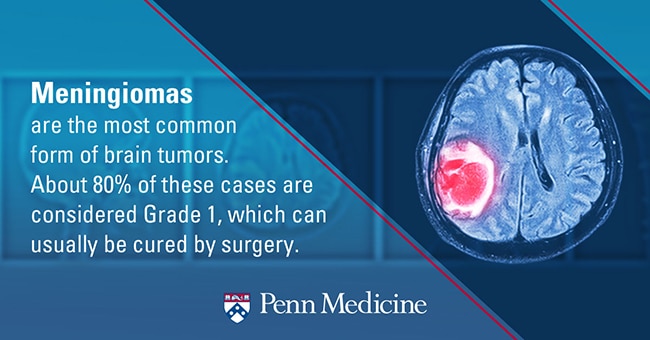
Support and Coping Strategies
A meningioma diagnosis can be overwhelming not only for the patient but also for their loved ones. It is important to seek support and develop coping strategies to navigate through this challenging time.
Educating Yourself
Knowledge is power, and understanding the nature of meningioma, treatment options, and potential outcomes can help you make informed decisions and reduce anxiety. Consult reliable sources of information and ask your healthcare team any questions you may have.
Seeking Emotional Support
Emotional support is crucial when dealing with a meningioma diagnosis. Lean on family, friends, and loved ones for support, and consider seeking professional counseling or therapy to help manage the emotional impact of the diagnosis.
Joining Support Groups
Support groups can provide a sense of community and connection with others who are going through or have gone through similar experiences. Joining a support group can offer emotional support, practical advice, and a safe space to share thoughts and feelings.
Coping Strategies
Different coping strategies work for different individuals. Some common strategies include engaging in hobbies or activities that bring joy, practicing relaxation techniques like meditation or deep breathing, maintaining a healthy lifestyle with regular exercise and a balanced diet, and expressing emotions through journaling, art, or music.
Research and Advancements
Advancements in medical research are continually improving our understanding of meningioma and developing novel treatment approaches. Ongoing research efforts aim to enhance treatment outcomes and improve quality of life for meningioma patients.
Current Research
Current research focuses on a variety of areas, including further classification and subtyping of meningiomas based on genetic markers, identifying potential therapeutic targets and developing targeted therapies, investigating the role of immunotherapy in treating meningiomas, and exploring the use of novel imaging techniques for improved diagnosis and monitoring.
Emerging Treatment Approaches
Several promising treatment approaches are being explored, such as immunotherapy, targeted therapies, and novel drug combinations. Immunotherapy aims to boost the body’s immune response to target and eliminate tumor cells. Targeted therapies involve using drugs that specifically target certain molecules or pathways involved in tumor growth. These approaches have shown promise in other types of cancers and are being evaluated for their potential benefits in meningioma.
Promising Discoveries
Recent discoveries in genomic studies have shed light on genetic mutations and abnormalities associated with meningioma development and progression. These findings have the potential to pave the way for personalized medicine approaches and targeted therapies. Additionally, advancements in imaging technology, such as functional MRI and PET scans, are enabling more precise tumor characterization and treatment planning.
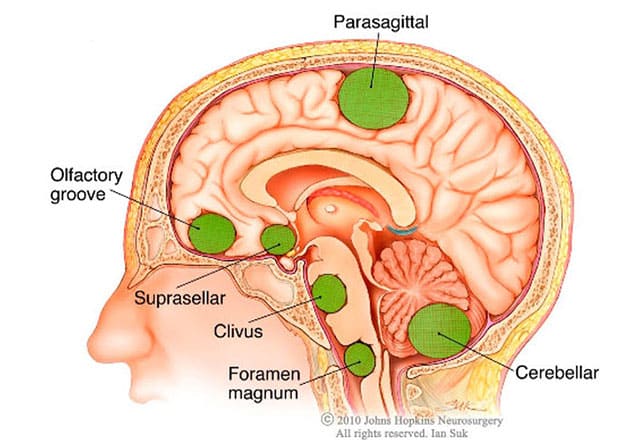
Prevention
While it may not be possible to prevent all cases of meningioma, there are steps individuals can take to reduce their risk and promote overall brain health.
Regular Check-ups
Regular check-ups with a healthcare professional can help detect any signs or symptoms of meningioma early on. This is especially important for individuals with a family history of meningioma or other risk factors.
Genetic Counseling
Individuals with a family history of meningioma or genetic syndromes associated with an increased risk of developing these tumors may benefit from genetic counseling. Genetic counselors can provide information about the potential risks, screening options, and preventive measures.
Lifestyle Modifications
Maintaining a healthy lifestyle can contribute to overall brain health. This includes eating a balanced diet, engaging in regular physical exercise, avoiding exposure to harmful radiation whenever possible, and taking steps to minimize the risk of head injuries.
Conclusion
Meningioma is a type of brain tumor that can have significant impacts on individuals and their families. While the exact cause of meningioma is unknown, advancements in research and treatment options are continuously improving our ability to diagnose and manage these tumors. Seeking medical care early, understanding the available treatment options, and accessing support systems can empower individuals and enhance their quality of life throughout their meningioma journey.
